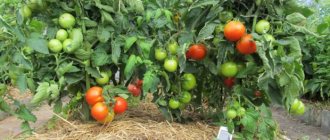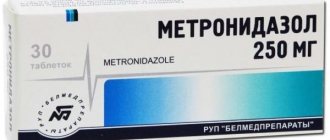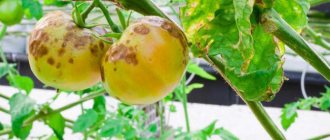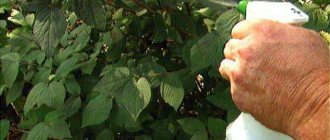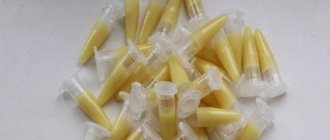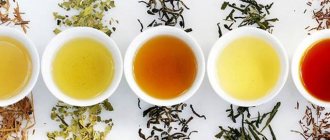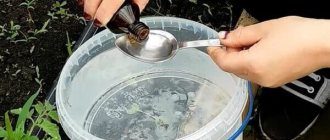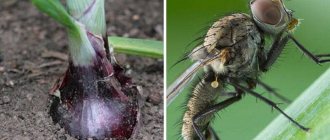What kind of disease is this
Fusarium is a dangerous fungal disease of tomatoes that is resistant to chemicals . Its distribution indicates errors in growing plants. The disease can be encountered both in greenhouses and in open ground in all climatic regions. It may take 2-3 weeks from the onset of the disease to the complete death of the plant.
How does it affect tomatoes?
The fungus attacks the vascular system of seedlings, as a result of which the roots and fruits begin to rot, and the plant itself begins to dry out. The photo shows that the disease spreads from bottom to top. The fungus can be found in the soil and enters the plant through damaged or small roots. As the disease progresses, rot appears on the root system, and fungi penetrate through the vessels into the stem and leaves.
The first sign of Fusarium wilt of seedlings is the falling of the lower leaves. However, this symptom is characteristic of many other ailments. Fusarium is accompanied by discoloration of the petioles and curling of the foliage.
Experienced gardeners have noticed that most often the disease affects plants grown in greenhouse conditions. However, if all conditions for tomato growth are met (temperature, humidity, lighting), it can be avoided. Fusarium wilt is also typical for seedlings grown year after year in the same place.
Treatment of fusarium in indoor plants
A houseplant infected with Fusarium should first be removed from the flowerpot. Remove any remaining soil from the roots. After this, rinse in water at room temperature. Affected eyelids, leaves, and bulbs should be cut off and thrown away. Rinse the flower again and sprinkle the cut areas with activated carbon. After this, transplant it into another pot.
Old soil needs to be frozen and calcined. This is the best way to get rid of the pathogen. It is resistant to frost and heat, but with prolonged exposure to the lowest and highest temperatures, it dies. Treatment with a fungicidal solution is an additional measure, insurance against accidents. New soil after replanting should also be treated with a fungicidal agent to ensure protection of the root system. In addition, it is necessary to spray the above-ground part.
Time will tell if the flower will survive. It is better to germinate cuttings, new seedlings, and move it to another room, ensuring optimal conditions in the new place. Seedlings can also be moved so that Fusarium does not have a chance to infect neighboring flowers.
Description of symptoms and external signs
It is very difficult to recognize fusarium in a timely manner, since its symptoms are similar to those of other diseases or soil depletion. Novice gardeners, not understanding the true reason for the drying out of tomatoes, begin to use various fertilizers that do not have an effect and can harm the plant.
Manifestations:
- pale green or yellow leaves;
- discoloration of the veins along which the plant sap moves;
- deformation of leaf petioles;
- leaf curling;
- falling of the lower leaves;
- gradual withering of the plant;
- the formation of white plaque on the roots at high humidity.
First, the lower leaves turn yellow and fall off, then the upper part of the green mass begins to change color, dry out and become deformed. The disease can be recognized by cutting the stem - the vessels become brown in color. If an infected plant is kept in a room with high humidity for several days, white mycelium of the fungus will be visible.
Peculiarity . The disease can be recognized only during flowering or fertilization of plants. During this period, the main phase of withering occurs.
Causes of appearance and infection
Fusarium is a fungal disease that not only parasitizes the plant, but also causes it to dry out. To select the correct treatment, you need to understand the nature of the pathogen and determine the conditions for its spread.
The causative agent of the disease
The causative agent is fungi of the genus Fusarium, living in the soil at a depth of 10 cm . Getting inside the plant, they affect its vascular system, in particular the veins through which juices circulate.
Fungi, when multiplying, completely clog these channels, which disrupts the nutrition of the green mass of the seedlings. Since the causative agent of the disease is inside the plant, it is very difficult to completely eliminate it without harming the tomato.
Microorganisms release compounds that negatively affect the condition of the leaves. As a result, they begin to curl and then fall off.
Important ! The causative agent of the disease is resistant to various chemicals, so it is very difficult to cope with it.
The fungus can remain in the soil and plant debris for a very long time, which can lead to infection of new crops.
Terms of distribution
The pathogen can be in the substrate, on garden tools, in seeds and soil. Pathogenic fungi do not interfere with the development of seedlings until conditions favorable for their spread are established.
Symptoms of the disease begin to manifest themselves clearly during the period when there are changes in air temperature: hot days give way to cold nights. If the temperature drops to 16°C, the plants will begin to rapidly die. Increased humidity promotes the active proliferation of fungi that attack the stems and leaves of plants.
Low nutrient content in the soil and errors in plant care can cause the spread of the disease. Growing seedlings in one place also creates favorable conditions for the proliferation of fungi.
Factors predisposing to fusarium:
- crowded beds;
- excessive use of chemicals;
- non-compliance with crop rotation;
- location of the site in a place where groundwater is close to the groundwater;
- shortening daylight hours;
- poor lighting in the greenhouse;
- drought, drying out of plant roots;
- close location to the garden of industrial zones.
Distribution methods:
- Through seeds - when the seed material is infected, the plant begins to dry out even during the period of fruit formation.
- Through roots - fungi located in the soil are introduced into the plant through damage to the root system.
Attention ! The pathogen can enter tomatoes through minor damage caused during pinching or transplanting.
How and with what to treat
Fusarium is a disease that must be treated. If left untreated, all plants may die. However, since the causative agent of the disease is resistant to chemicals, it is very difficult to cure tomatoes.
Important ! There is no point in treating severely damaged tomatoes - they are uprooted and burned.
Chemicals
Medicines against fusarium can be chemical or biological. Biological ones do not contain chemical components; they are bacteria that can neutralize pathogenic fungi. Such products are considered quite effective, as they saturate the soil with beneficial microorganisms, which reduces the likelihood of the appearance of dangerous bacteria.
At the first signs of the development of Fusarium wilt, the biological drug Trichodermin is effective. For one bush of an adult plant, 0.5 liters of solution is enough; the drug is poured under the root. This product is also suitable for preventive soil treatment before planting seedlings: 1 kg of product per 10 square meters. m.
Biological agents to combat the disease also include Trichocin, Alirin-B, and Gamair. Planriz and Pseudobacterin-2 are suitable for watering sick plants. 100 ml of solution is consumed per bush.
Chemical preparations are more effective than biological ones, but have a significant drawback: after treatment, you cannot eat fruits from a diseased plant for several weeks. Experts recommend applying the treatment no later than three weeks before harvest.
You can spray the affected leaves of the plant with the preparation “Falcon” - 1 mg of the product is needed for 3.3 liters of water. The procedure is carried out using a fine spray, treating the stem and leaves on both sides. The drugs Previkur, Strekar, Benazol and Fundazol also showed good results in the treatment of fusarium.
Traditional methods
Practice has shown that it is possible to stop the development of Fusarium wilt without the use of special drugs. To make the fruits as environmentally friendly and safe as possible, you can use dolomite flour or lime. The products are generously laid out on the beds.
For watering and spraying, you can use a solution of manganese or preparations containing copper.
Agrotechnical techniques
Following the rules of crop rotation allows you to avoid many diseases. They involve regularly changing the site for growing tomatoes. Tomatoes can be planted in their original place only after 3-4 seasons. Good predecessors for nightshades are cabbage, pumpkin and cucumber. But it’s better not to plant tomatoes in place of eggplants, peppers, potatoes and physalis.
If the gardener does not have the opportunity to plant seedlings in another place, and the disease has already appeared earlier, then when buying seeds it is worth choosing varieties that are resistant to the fungus.
These include:
- De Barao;
- Blitz;
- Orco F1;
- Raisa;
- Pink Giant;
- Monica;
- Rusich;
- Rhapsody;
- Sun;
- Sorento;
- Plot;
- Senzafin F1;
- Martin;
- Charisma F1;
- Carlson;
- Spartak F1;
- Miron F1;
- Vologda F1;
- Ural F1.
Moderate use of fertilizers will also promote healthy plant growth. Before planting seedlings, it is recommended to fertilize the soil abundantly using natural ingredients: compost or manure. If the gardener does not have the opportunity to fertilize with organic substances, then nitrogen-containing preparations can be used.
Treatment of fusarium in garden plants
Most of the drugs that are used to treat fusarium in cucumbers, carrots, and strawberries can also be used for prevention. Bad weather, dampness, cloudy days, cold weather are favorable conditions for the microorganism. The spores manage to cause harm to the plant, and the process of spreading through the blood vessels begins if:
- his immunity is initially weakened by improper watering and nutrition;
- if branches and foliage were damaged;
- when preventive spraying was not carried out.
It is important to follow the rules for caring for seedlings and mature plants.
Universal drugs
Fungicide Alirin-B protects against a wide variety of fungal infections. This disease is also among them. This biological product is harmless to plants, humans, and animals. Suitable for both garden and indoor crops. Watering the soil before planting seedlings, sowing seeds, and spraying before flowering is the key to success. Many other fungicides have worked well. Their versatility allows you not to spend a lot of money on protecting plants from common diseases.
Chalk and dolomite flour are also used to neutralize spores in the soil. Unfavorable conditions are created. These remedies should be used when the problem has already been eliminated, so that next year you will not have to treat vegetables, flowers, trees, or lawn grass again.
What to do if you notice signs of fusarium
If infected plants are detected, you must:
- cut off damaged parts;
- burn them;
- Treat the cut areas with a solution of potassium permanganate, ash or sulfur;
- annual plants and severely damaged ones can be uprooted and burned.
You should not eat fruits in which toxins produced by the fungus may have accumulated, or its spores remain.
Even if they look good, there are no guarantees. The goal of treating fusarium is to save those crops that can produce a harvest next year. Completely updating your garden, vegetable garden, and the list of cultivated varieties is not a joyful prospect, it is a very real threat.
Preventive measures
It is impossible to completely get rid of fusarium; its causative agent may still remain in the vascular system of the plant. Planting disease-resistant tomatoes does not guarantee protection against fungus.
Prevention:
- cleaning the area from plant residues after harvesting;
- preparing the land for planting seeds: digging, disinfecting, loosening;
- disinfection of seed material: heating or treatment with fungicides;
- regular ventilation of the greenhouse;
- providing additional lighting;
- disinfection of garden tools and garter material;
- mulching beds;
- carrying out pinching using pruning shears;
- regular hilling of seedlings.
Prevention
A plant infected with fusarium cannot be cured. That's why timely prevention is so important. Preventive measures, in addition to the use of drugs, include:
- maintaining the soil in a loose state. Liming soil that is too acidic will reduce the risk of fusarium;
- compliance with crop rotation;
- pre-sowing inspection, selection and disinfection of planting material;
- dosed use of organic matter and mineral nitrogen;
- regular removal of weeds from the site; contaminated plant debris should not be composted;
- extermination of pests that carry infection.
In the fight against fusarium there must be an integrated approach. This is the only way to get a good harvest from healthy plants.
You will learn more about fusarium blight on different plants from the video.
Advice from gardeners
The disease mainly affects plants grown in greenhouses. You can reduce the risk of disease by regularly ventilating the room after evening watering. It would be useful to equip it with a good ventilation system.
Pre-planting seed treatment is the key to plant health. The material must be treated with drugs belonging to the group of benzimidazoles, for example, “Fundazol” or “Benazol”. Disinfection is carried out two weeks before planting; 5-6 g of product will be needed per 1 kg of seeds. The drug is dissolved in water, after which the solution is poured into a spray bottle. Seeds placed in a container are sprayed and mixed. 20-30 minutes after the procedure, the material is scattered to dry and then placed into bags.
According to reviews from summer residents, the development of the disease can be avoided by carrying out additional treatment of the roots. The root system of the seedlings is dipped into the fungicide solution for a few seconds, after which they need to be dried a little and planted in the garden bed.
Pre-planting soil treatment can also protect against Fusarium wilt. For disinfection, you can use copper sulfate: 70 g of the product is dissolved in one bucket of water. Dolomite flour or chalk will also help neutralize fungi.
It has been observed that pathogenic fungi do not respond well to mulching. Most summer residents use straw for these purposes, but you can also try putting black film on the beds - the material inhibits pathogens.
After harvesting, the gardener needs to clear the area of vegetation and disinfect the soil. For these purposes, use lime, potassium permanganate solution or a mixture of ash and powdered sulfur.
